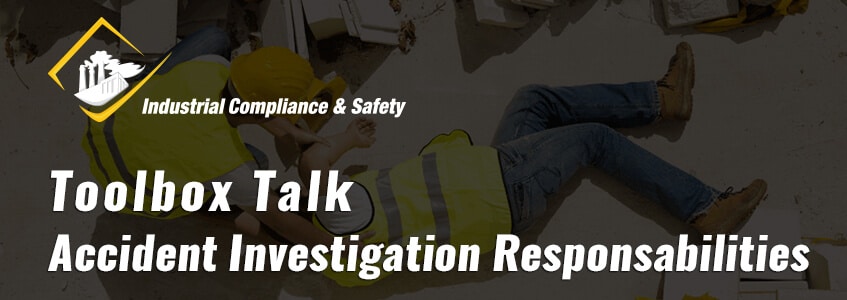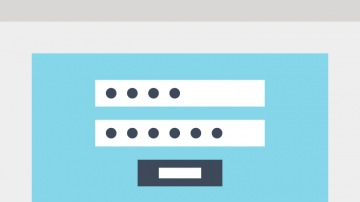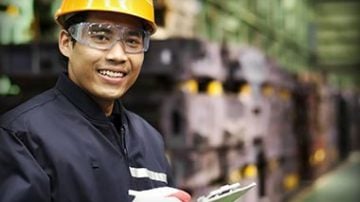It is important to have a thorough structure in place for construction accident investigations. If management, supervisors, and employees know their roles in the aftermath of an accident, then the cause of the accident can be quickly identified and corrected. When everyone clearly understands their responsibilities after a worksite accident, then the entire company can work together to make the workplace safer for all. Additionally, using critical thinking skills in construction accident investigations can sharpen your employees’ awareness, and nudge them to use the same skills to recognize potential hazards in the future.
What is an Accident Investigation?
After an accident occurs, it is important to launch a prompt, thorough investigation. An accident investigation involves a systematic collection and analysis of information related to the accident. Investigations can be carried out for property loss or an injury to an employee. It is a scientific way of analyzing all facts and contributing factors to a job site accident. A properly done investigation identifies the root cause of an accident in an effort to make necessary changes to prevent the same accident from happening in the future.
Guidelines for Safety Discussion:
Principles & Steps of an Accident Investigation
Investigations help pinpoint the cause of an accident, and they help to identify and correct any problems, hazards, or gaps in your current safety procedures. During accident investigations, everyone has a set of specific responsibilities. These responsibilities depend upon a person’s role in the company.
Information to Collect
- Environment Details: What, when, where, who and how the incident occurred
- External Factors: State of health of individual, work related factors and management factors
- Parties Involved: List of everyone who has been involved in the incident, the investigation and the reporting
Role Responsibilities During an Accident investigation
Management:
- Properly train all supervisors to both prevent and investigate worksite accidents.
- Ensure all accidents and injuries are properly investigated.
- Oversee the implementation of corrective measures after the cause of an accident is determined.
- Organize and archive all accident reports.
- Ensure that all accident reports are properly recorded within the OSHA log.
Supervisors:
- Personally manage immediate construction accident investigations.
- Communicate with management immediately after the event occurs.
- Communicate with employees and direct them to safety if necessary.
- Do not assign or imply blame for accidents.
- Collect and preserve all evidence that may be useful in an investigation (including photographs).
- Interview witnesses, as well as any injured workers if they are in stable condition.
- Take action to correct any problems revealed in the accident investigation.
Employees:
- Be aware of your surroundings at all times. Pay attention to your coworkers, and communicate if you notice a potential hazard.
- Report any dangerous conditions and near-misses to the supervisor.
- Immediately report any worksite accidents or injuries to the supervisor.
- Assist as requested in all accident investigations, and communicate your perspective if you were a witness to the accident.
Benefits of Conducting Accident Investigations
It is important to document any incidents or injuries for record keeping, insurance purposes and proactive development of new or refined safety measures. When we can determine the root cause of an injury, we can assess how likely the recurrence of that incident is and make the necessary changes to prevent anyone else from falling to the same injury. An accident investigation also demonstrates organizational concern to your employees. This naturally helps to widen employee confidence and improve public relations. Determining the exact cause of the incident;
Construction Site Accident Preventative Measures
Prevention is key to maintaining a safe workplace environment. Knowing what to look for and the steps you can take to help prevent accidents from happening will keep your employees safer and keep your company insurance premiums down.
Examples of unsafe conditions that can lead to job site injuries:
- Use of equipment by untrained personnel
- Running or other hasty movements, especially around heavy machinery or moving parts
- Goofing off, practical jokes, or pranks
- Use of damaged personal protective equipment (PPE)
- Incorrect or insufficient use of PPE
- Impairment by drugs or alcohol
- Ergonomic hazards
- Environmental hazards
- Inadequate machine guarding, caution tape, or warning signs
- Untreated health conditions (chronic or spontaneous, such as heat exhaustion, excessive fatigue, and frostbite)
If any of the above conditions are ever noticed by an employee, he or she should report concerns to the supervisor. Open communication goes a long way in worksite accident prevention. A proactive approach that asks for employee feedback and suggestions can also help you implement better safety measures.
Additional Discussion Notes:
After reading through the list of responsibilities and examples of unsafe conditions, take some time at the end of the meeting to ask your employees whether or not they have noticed anything unsafe that could be improved. For instance, you could redesign a work station for improved visibility, rewrite a safety policy, implement new caution signs, or retrain your employees in a specific matter. Understanding these steps ahead of time allows you to act immediately following incidents at your worksite. As such, it’s both key to saving time and conducting more thorough construction accident investigations.
Disclaimer
The information contained within this document (both the online and downloadable version) is provided for informational purposes only. Nobody shall take this as a comprehensive or exhaustive resource on this topic. This material is believed to be accurate, however, the information has been compiled from multiple sources, and so Industrial Compliance & Safety assumes no responsibility for the accuracy of this information. We encourage you to consult experts about this specific Toolbox Talk to ensure you are compliant with any and all safety regulations and processes. In no event does the content of this document supersede any applicable local, state, or federal statutes or regulations.





